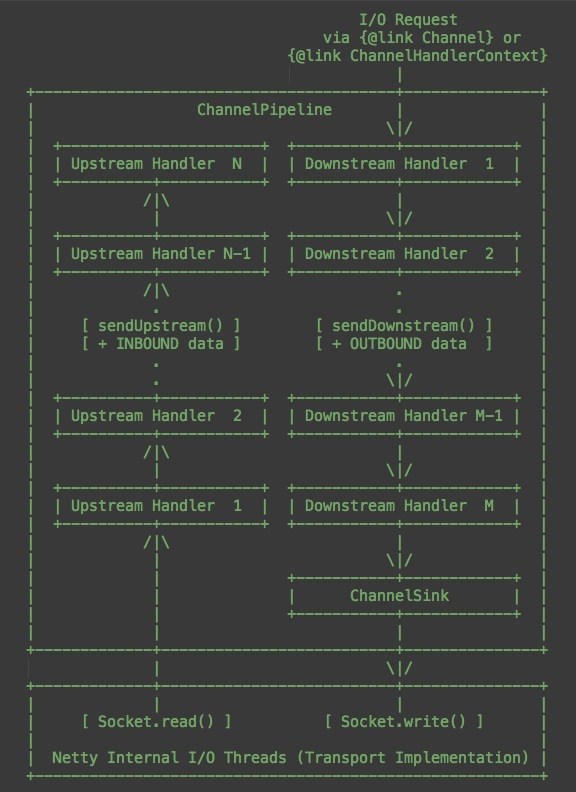前言
netty做了什么工作
Java 的标准类库,由于其基础性、通用性的定位,往往过于关注技术模型上的抽象,而不是从一线应用开发者的角度去思考。java nio类库的三个基本组件bytebuffer、channel、selector。java只是将这三个组件赤裸裸的提供给你,线程模型由我们自己决定采用,数据协议由我们自己制定并解析。
从功能角度
- 从网络协议的角度,Netty 除了支持传输层的 UDP、TCP、SCTP协议,也支持 HTTP(s)、WebSocket 等多种应用层协议,它并不是单一协议的 API。
- 在应用中,需要将数据从 Java 对象转换成为各种应用协议的数据格式,或者进行反向的转换,Netty 为此提供了一系列扩展的编解码框架,与应用开发场景无缝衔接,并且性能良好。
- 扩展了 Java NIO Buffer,提供了自己的 ByteBuf 实现,并且深度支持 Direct Buffer 等技术,甚至 hack 了 Java 内部对 Direct Buffer 的分配和销毁等。同时,Netty 也提供了更加完善的 Scatter/Gather 机制实现。
单独从性能角度,Netty 在基础的 NIO 等类库之上进行了很多改进,例如:
- 更加优雅的 Reactor 模式实现、灵活的线程模型、利用 EventLoop 等创新性的机制,可以非常高效地管理成百上千的 Channel。
- 充分利用了 Java 的 Zero-Copy 机制,并且从多种角度,“斤斤计较”般的降低内存分配和回收的开销。例如,使用池化的 Direct Buffer 等技术,在提高 IO 性能的同时,减少了对象的创建和销毁;利用反射等技术直接操纵 SelectionKey,使用数组而不是 Java 容器等。
- 使用更多本地代码。例如,直接利用 JNI 调用 Open SSL 等方式,获得比 Java 内建 SSL 引擎更好的性能。
- 在通信协议、序列化等其他角度的优化。
| java.nio | netty | |
|---|---|---|
| bytebuf | netty的bytebuf提供的接口与nio的bytebuffer是一致的,只是功能的增强,bytebuf只有在编解码器中才会用到 | |
| selector | 完全隐藏 | |
| channel | 完全重写 | |
| 线程模型 | 固定好了 |
channel
netty channel: A nexus to a network socket or a component which is capable of I/O operations such as read, write, connect, and bind.
- All I/O operations are asynchronous.
- Channels are hierarchical, channel有一套继承结构
channel如何重写呢?AbstractChannel类特别能说明问题。AbstractChannel聚合了所有channel使用到的能力对象,由AbstractChannel提供初始化和统一封装,如果功能和子类强相关,则定义成抽象方法,由子类具体实现。
AbstractChannel{
Channel parent;
Unsafe unsafe;
// 读写操作全部转到pipeline上
DefaultChannelPipeline pipeline;
EventLoop eventloop;
// 因为channel 提供纯异步结构,除了正常的io通信外,close 等操作也需要提供 xxFuture 返回,接收close future回调并执行
SuccessedFuture,ClosedFuture,voidPromise,unsafeVoidPromise
localAddress,remoteAddress
}
pipeline
filter能够以声明的方式插入到http请求响应的处理过程中。
inbound事件通常由io线程触发,outbound事件通常由用户主动发起。
ChannelPipeline的代码相对比较简单,内部维护了一个ChannelHandler的容器和迭代器(pipeline模式都是如此),可以方便的进行ChannelHandler的增删改查。
- ChannelPipeline
- DefaultChannelPipeline
- ChannelHandler
- ChannelHandlerContext,**Enables a ChannelHandler to interact with its ChannelPipeline and other handlers. ** A handler can notify the next ChannelHandler in the ChannelPipeline,modify the ChannelPipeline it belongs to dynamically.
几个类之间的关系
channelpipeline保有channelhandler的容器,这在java里实现办法可就多了
- channelpipeline直接保有一个list(底层实现可以是array或者list)
- 链表实现,Channelpipeline只保有一个header引用(想支持特性更多的话,就得加tail)。只不过这样有一个问题,handler本身要保有一个next引用。如果既想这么做,又想让handler干净点,那就得加一个channelhandlercontext类,替handler保有next引用。
代码如下
channelpipeline{
channelhandlercontext header;
}
channelhandlercontext{
channelhandler handler;
channelhandlercontext next;
EventExecutor executor;
@Override
public ChannelHandlerContext fireChannelActive() {
final AbstractChannelHandlerContext next = findContextInbound();
EventExecutor executor = next.executor();
if (executor.inEventLoop()) {
next.invokeChannelActive();
} else {
executor.execute(new OneTimeTask() {
@Override
public void run() {
next.invokeChannelActive();
}
});
}
return this;
}
private void invokeChannelActive() {
try {
((ChannelInboundHandler) handler()).channelActive(this);
} catch (Throwable t) {
notifyHandlerException(t);
}
}
}
从这就可以看到,Channelhandlercontext不只是替Channelhandler保有下next指针,将pipeline的fireChannelxxx 转化为channelhandler的channelxxx方法。
A list of ChannelHandlers which handles or intercepts inbound events and outbound operations of a Channel. ChannelPipeline implements an advanced form of the Intercepting Filter pattern to give a user full control over how an event is handled and how the ChannelHandlers in a pipeline interact with each other.
inbound 的被称作events, outbound 的被称作operations。

从这个图就可以佐证,pipeline作为数据处理模型,不介入io模型,也不介入线程模型。
小结
回过头来再看,java nio类库的三个基本组件bytebuffer、channel、selector,数据的读写就是这三个组件的相互作用,线程模型的选择留给用户。netty则是使用eventloop隐藏了selector(将selector和线程绑在一起),使用pipeline封装了数据的处理,在它们复杂关系的背后,它们的起点,或许还是那个最简单的NIOServer程序。
